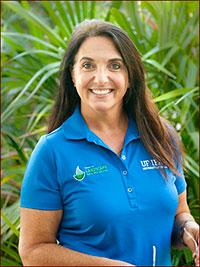Wendy's Wanderings
 Happy New Year
Happy New Year
January 6, 2016
This is the month that we resolve to make changes in our lives for the better. For a happier and healthier 2016, why not make some landscaping and gardening resolutions?
I always look for some easy things to quickly mark off my list, so for my first "Wanderings" column of 2016, I thought I might share a few simple landscaping resolutions.
Remove invasive plants. Invasive plants can escape from our landscapes and push out native plants, harming the natural habitats of Florida. If you have invasive plants like air potato vine, Mexican petunia, or coral ardisia, make a plan for getting rid of them and replacing them with Florida-Friendly or native plants. Manual removal (pulling) works best to get rid of these weeds. Not sure which plants are invasive? Visit the UF/IFAS Assessment of Non-native Plants in Florida's Natural Areas.
Plant more edible plants. Try to make your landscape more sustainable and productive by putting in a raised bed garden for vegetables or herbs, or plant a fruit tree or two. Pick a site in the yard that gets plenty of sunshine and is close to a water source. Get more information from the Florida Vegetable Gardening Guide.
Use more mulch. Most of us in Florida love our trees, but with trees come lots of shade. If you are trying to grow turf grass in a heavily shaded area, you might be wasting your time and energy. Instead, consider mulching the area with 3-4 inches of recycled leaves or pine bark. You could also use a shade-tolerant groundcover like native ferns, mondo grass or partridge berry.
Use the least toxic pesticide first to control pest problems. There are quite a few botanical pesticides and "soft" pesticides available that are easier on the environment and still control insects. But remember, just because they're natural doesn't mean they aren't toxic, so always follow the label instructions. And healthy plants growing in ideal conditions rarely have insect problems, so always put the right plant in the right place.
Fertilize conservatively and appropriately to protect our environment. Select fertilizers that have a good portion of their nitrogen in a slow-release or water-insoluble form. This will provide a slow feed to your plants or lawn grass and helps prevent excess nitrogen leaching into our water. Fertilize only when established trees or shrubs show deficiency, and not on a routine basis.
Conserve water in the landscape. Use plants that require less water to thrive and look beautiful. You can search for drought-tolerant plants at Florida-Friendly Landscaping™ website. Irrigate in the early morning hours and only on the day or days assigned by your Water Management District. Calibrate your sprinklers to deliver ½ inch to ¾ inch of water. This amount fills the root zone of the plants without overwatering.
Refer to the UF/IFAS Florida-Friendly Landscaping™ website for more information about creating a landscape that's beautiful and healthy for Florida. Even a few changes that you can make in your landscaping and yard maintenance can save you money, protect the environment, and make for a happier, healthier, greener 2016.
-- Wendy Wilber

